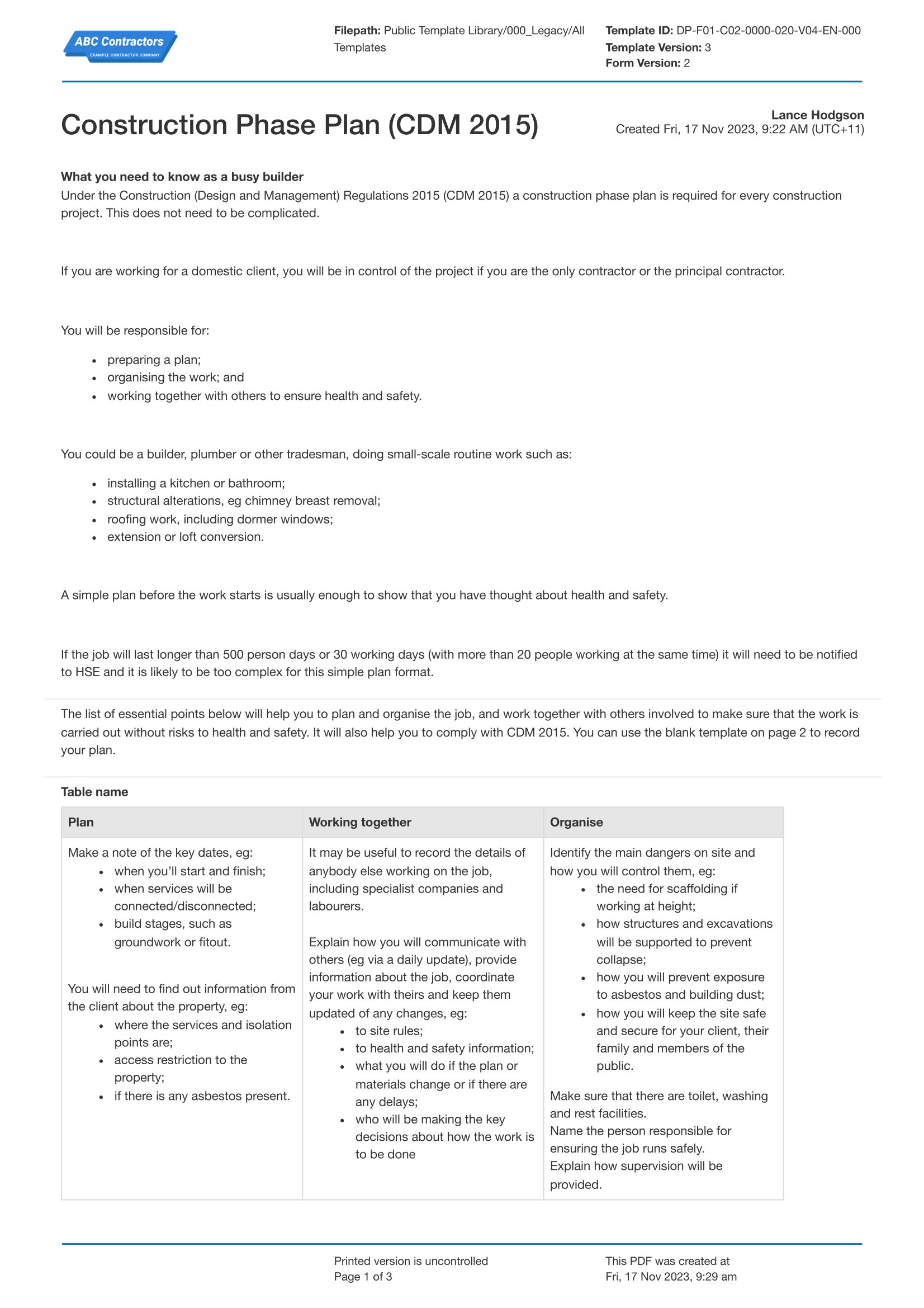A well-crafted construction phase plan can mean the difference between project success and costly delays – here’s what you need to know.
Understanding Construction Phase Plans: The Basics
A Construction Phase Plan (CPP) is a legally mandated document in the UK under the Construction (Design and Management) Regulations 2015. It serves as the cornerstone of site safety and project management, required for all construction projects, regardless of size or duration. Statistics show that projects with well-implemented CPPs experience up to 40% fewer safety incidents and significantly reduced delays. The plan must be in place before construction work begins, acting as a comprehensive roadmap for managing health, safety, and environmental risks throughout the project lifecycle. For smaller domestic projects, a simple plan might suffice, while larger commercial developments require more detailed documentation. The key is ensuring the plan is proportionate to the project’s complexity and risk level.
Essential Components of Your Construction Phase Plan
1. Project Information and Scope
- Detailed project description including location, type of work, and expected duration
- Key milestone dates and project phases
- Client details and project stakeholders
- Site-specific information including access points and existing services
- Budget considerations and resource allocation
- Planning permissions and regulatory compliance requirements
2. Management Structure and Responsibilities
The management structure section forms the backbone of your CPP, establishing clear lines of authority and accountability. It must detail the roles and responsibilities of all duty-holders, including the principal contractor, designers, and subcontractors. Recent industry data shows that projects with clearly defined management structures are 35% more likely to complete on time. Include contact information for key personnel, communication protocols, and reporting hierarchies. This section should also outline how different teams will coordinate their activities and how information will flow between stakeholders.
3. Risk Assessment and Control Measures
- Comprehensive site-specific risk assessments
- Control measures for work at height, excavations, and confined spaces
- Plant and equipment safety protocols
- Traffic management and pedestrian safety measures
- Hazardous substance handling procedures
- Noise and vibration control strategies
Site Management and Safety Procedures
1. Daily Operations Protocol
Effective daily operations management is crucial for maintaining site safety and efficiency. Your CPP should outline specific procedures for site inductions, with statistics showing that thorough induction processes reduce workplace accidents by up to 25%. Include details about training requirements, security measures, and access control systems. Specify how toolbox talks will be conducted, their frequency, and documentation requirements. Detail the process for managing visitors and contractors, including sign-in procedures and PPE requirements.
2. Emergency Procedures
- Emergency contact numbers and chain of command
- Evacuation routes and assembly points
- First aid arrangements and locations of medical equipment
- Fire safety measures and equipment locations
- Incident reporting and investigation procedures
- Emergency service access routes
3. Environmental Controls
Environmental management has become increasingly important in construction, with UK regulations requiring specific measures to minimise environmental impact. Your CPP should detail waste management procedures, including segregation and disposal methods. Include measures for dust suppression, noise control, and protection of local wildlife. Specify procedures for handling hazardous materials and preventing soil or water contamination. Recent studies indicate that projects with robust environmental controls can reduce their carbon footprint by up to 30%.
Implementing and Maintaining Your CPP
1. Documentation and Record Keeping
Maintaining accurate records is essential for legal compliance and project success. Implement a systematic approach to documentation, including regular reviews and updates of the CPP. Establish a clear process for recording site inspections, incidents, and changes to working methods. Industry best practice suggests reviewing the CPP at least monthly, with immediate updates when significant changes occur.
2. Communication Strategy
- Regular site meetings and briefing schedules
- Methods for distributing updates and changes
- Digital platforms for document sharing
- Feedback mechanisms for workers and stakeholders
- Language considerations for diverse workforces
Common Pitfalls and How to Avoid Them
Many construction projects stumble due to inadequate CPPs. Common mistakes include insufficient detail in risk assessments, unclear communication channels, and failure to update the plan as work progresses. Research indicates that 65% of project delays can be traced back to poorly maintained CPPs. To avoid these pitfalls, ensure your plan is specific to your project, regularly reviewed, and effectively communicated to all stakeholders. Consider appointing a dedicated person responsible for maintaining and updating the CPP.
Making Your CPP Work in Practice
The success of your CPP depends on practical implementation. Ensure all workers understand their roles and responsibilities through regular training and communication. Use digital tools to make the plan easily accessible and updatable. Monitor compliance through regular site inspections and audits. Projects that actively engage workers in CPP implementation see a 40% increase in safety compliance. Remember that the plan should be a living document that evolves with the project.
Final Thoughts: Ensuring CPP Success
A well-structured and properly implemented Construction Phase Plan is essential for project success. Focus on creating a clear, practical document that addresses site-specific risks and can be easily understood by all stakeholders. Regular reviews and updates ensure the plan remains relevant throughout the project lifecycle. Remember, the goal is not just compliance but creating a safer, more efficient construction environment. By following these guidelines and maintaining active engagement with your CPP, you’ll significantly increase your chances of project success while ensuring the safety and wellbeing of everyone involved.
FAQ
What is the construction phase?
What is the construction phase? The construction phase is the physical process of building and all other associated activities such as landscaping, refurbishing, site clearance, and demolition. The contractor typically performs the construction work.
What is a CDM risk assessment?
A CDM risk assessment is a systematic process. It helps test, identify, and manage risks that could arise during a construction project. Common health and safety risks are key considerations in any construction project. These risks include falls when working at height, and risks when cleaning or maintaining equipment.
When should RAMS be provided?
RAMS are normally required when tendering for work with a Client, as the Client will use them to assess if you plan to carry out the task (etc) safely – this being part of their ‘Duty of Care’ when vetting Contractors.
What is the difference between a construction phase plan and a rams?
RAMS (Risk Assessments & Method Statements) are more specific documents focusing on individual tasks or activities. A Construction Phase Plan also identifies potential risks and outlines measures to manage them.
What does CDM stand for in construction?
The Construction (Design and Management) Regulations (known as the CDM regulations) are a set of health and safety regulations that apply specifically to construction projects.
Sources
[1] https://www.goconstruct.org/educational-resources/learn-about-construction/construction-phase-plan
[2] https://sitemate.com/resources/articles/safety/what-main-headings-should-a-construction-phase-plan-contain/
[3] https://www.bigrentz.com/blog/phases-of-construction


Leave a Reply